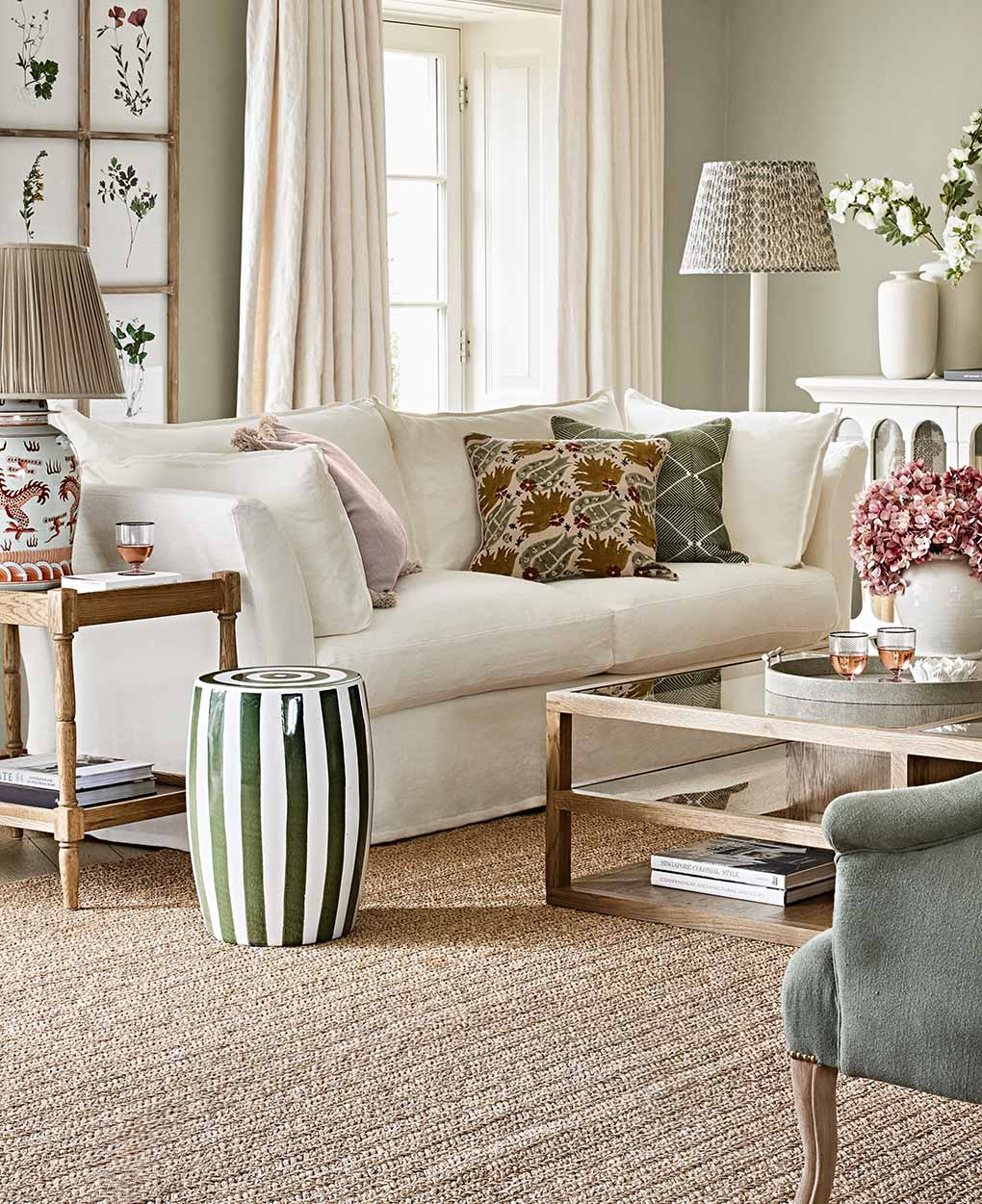Caring for fabric upholstery
OKA’s handcrafted furniture is made with great care, using carefully selected materials. With the correct maintenance, OKA furniture will provide years of comfort. Please familiarise yourself with the following information to ensure your complete satisfaction.
Fabric features
- Extra care should be taken with liquids as they may leave marks.
- Fabrics with a linen and/or cotton content can pill (form bobbles on the surface) and have fine threads visible. Some may have an uneven thickness in the fabric (known as slubs) and may include occasional seeds and husks from the natural fibre.
- Linen has a natural tendency to crease which enhances its textural appearance; creases will soften as the fabric relaxes in use. Pilling (bobble forming on the surface) is also a characteristic of such fabrics that can occasionally occur in early stages of use.
- Due to the methods of dyeing used with certain fabrics, there may be variations in colour and shading, which can occur within the same dye lot.
- Every effort is made to ensure the products supplied correspond as closely as possible to display items in our showrooms, and images used in our catalogues and on our website. However, due to unique characteristics of natural materials, variations may occur.
Loose covers
- These create a more casual fit than fixed covers and offer versatility for cleaning and updating your look.
- Loose covers have an allowance for up to 3% shrinkage (which will vary from fabric to fabric) when cleaned and may not fit tightly on arrival.
- Loose covers are supplied separately from the frame and will require fitting upon arrival. Some of the loose covers may be slightly creased, but the creases will drop out naturally with time and use.

Seat cushions, fillings & seat covers
The appearance and performance of your cushions can be preserved by regular maintenance.
Follow these simple steps as soon as your furniture arrives:
Foam with Fibre Wrap
- This is a firmer and more supportive filling than fibre which softens with use. It is often used on fixed seat cushions and pads.
- Due to small tolerances in the polyurethane foam manufacturing process, hardness of foam may vary from cushion to cushion within the same product order; the variance may reduce with use over time.
- If your loose cushions are foam filled, plump them occasionally to restore air between the fibres and maintain the shape.
- Seat covers should be rotated regularly to realign the seat edges.
Fibre or Feather
- These soft and comfortable fillings require frequent maintenance.
- On occasion, plump cushions firmly to restore air between the fibre or feather; this will maintain the look and comfort and help prevent the filling binding or flattening. Complete the following maintenance routine at least once a week; the more often this is carried out, the better the filling will perform.
1. Place the cushion on one of its outside edges and beat the opposite border of the cushion inwards with the flat of your hands. The more vigorously you do this, the better.
2. Turn the cushion round a quarter turn onto the next side and repeat until all four sides have been beaten.
3. Finally, give the cushion a shake and replace.
4. Occasionally remove the filling interiors from their covers to plump them.
All Cushion Fillings
- Fillings which are not maintained correctly from the beginning will bind and become difficult to restore, losing comfort and shape.
- Swap reversible cushions around and turn where possible to ensure equal wear.
- Selected upholstery ranges have cushion covers which are not fully reversible. Non-reversible fibre-filled cushions should have the pad removed from the cover and turned over occasionally.
- Cushions are likely to have moved during transit and, as they need time to settle, this may cause slight lifting of the back pads. Rotation may be required so they sit correctly: ensure the cushion pads are positioned well back, squarely and flat on the seating platform so backs sit flat to the seat.
- The feel of the seat will vary dependent on the fabric and size chosen; fabric compositions differ from fabric to fabric, which can give a more relaxed or firm feel to the seat when in use. Larger versions of a range have more cushion surface area for air to escape, so may become more compact and feel different to smaller options in the same range.

Sofa and Bed skirts
- Any creasing or wrinkles caused by packaging will drop out after a short period of time.
Fire retardancy
- All foam is manufactured to meet stringent flammability regulations. Any additives used to comply with this standard may occasionally have a slight odour which will dissipate over time.
Sunlight and environment
- If upholstery is exposed to direct sunlight for long periods of time, it will cause the colour and fabric to deteriorate or discolour. Use in hot and sunny rooms is not recommended.
- We recommend leaving at least a 30cm clearance from heat sources, such as radiators, to prevent colour change or permanent marks occurring.
- Do not place hot items such as cups, laptops or hot water bottles on the fabric as this may leave a mark.
- We do not recommend placing products in excessively high or low temperatures, or where the environment is often damp, as this may cause product issues.

General maintenance instructions
To help prolong the life of your upholstery, we advise the following:
Cleaning
- Regular cleaning with a soft brush and/or gently hoovering helps keep your furniture looking its best. Accumulated dust will accelerate the wear of covers.
- Periodic cleaning of the entire piece is essential to maintain appearance and prevent premature fading and wear.
- All upholstery products should be professionally cleaned unless otherwise stated. We recommend using a reputable upholstery care professional.
- We recommend requesting that a colour test is performed on an inconspicuous area before any professional cleaning commences, as OKA cannot take responsibility for third party damage or discolouration.
- Do not dry clean or wash covers unless it is specifically stated that you can, as doing so could result in a loss of fire-retardant properties and cause fabric durability issues.
- Remove all spills immediately. Blot liquid spills with a clean, dry, white cloth and work towards the centre of the spill. Do not rub or use abrasive cleaners as this may damage the furniture. Should the piece become stained or suffer other damage, we recommend seeking professional advice or help.
- For wooden components, use a lightly damp cloth rinsed in warm water; do not use washing powder. Polish periodically with a natural wax.
Care
- Avoid sitting on the arms or edges of the furniture as this may cause distortion. Pushing feet against or placing them on the piece may cause damage to the arm or frame.
- Please do not allow your furniture to be jumped on as this will damage the springs and frame.
- Take care to prevent sharp objects such as toys, buckles, garment studs and heels from coming into contact with your furniture as they may cause damage. We recommend you discourage domestic pets from climbing on or clawing upholstery. If snags do occur, do not pull them; instead, thread back in gently.
- Avoid air pollution such as cigarette smoke and cooking fumes, which can cause fabric to fade or change colour.
- Avoid contact with chemicals such as baby wipes (with the exception of our clever velvet), haircare and skincare products, insect repellents and other cosmetics, and household cleaning materials other than those recommended, as these are likely to damage the surface.
- Take great care when unzipping covers and replace them correctly. Never force a zip and avoid trapping fabric when fitting or lifting items by the zips.
